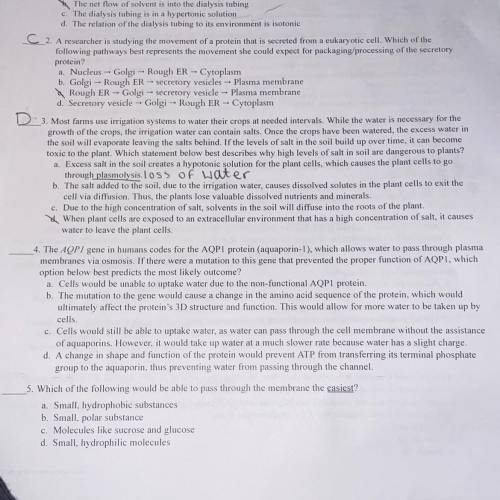
Biology, 21.10.2021 08:20 treylartigue
4. The AQP/ gene in humans codes for the AQP1 protein (aquaporin-I), which allows water to pass through plasma
membranes via osmosis. If there were a mutation to this gene that prevented the proper function of AQP1, which
option below best predicts the most likely outcome?
a. Cells would be unable to uptake water due to the non-functional AQPI protein.
b. The mutation to the gene would cause a change in the amino acid sequence of the protein, which would
ultimately affect the protein's 3D structure and function. This would allow for more water to be taken up by
cells.
c. Cells would still be able to uptake water, as water can pass through the cell membrane without the assistance
of aquaporins. However, it would take up water at a much slower rate because water has a slight charge.
d. A change in shape and function of the protein would prevent ATP from transferring its terminal phosphate
group to the aquaporin, thus preventing water from passing through the channel.


Answers: 2
Another question on Biology


Biology, 22.06.2019 03:30
Based on the topographic map of mt. st. helens, what is the contour interval of the volcano about height is 2,950 m?
Answers: 2

Biology, 22.06.2019 04:00
Will mark brainliest i only need the ! 1.use ten beads and a centromere of one color to construct the long chromosome. use ten beads and a centromere of a second color to construct the second chromosome in the long pair. make a drawing of the chromosomes in the space below. 2. for the second pair of chromosomes, use only five beads. 3. now model the replication of the chromosomes. make a drawing of your model in the space below. part b: meiosis i during meiosis i, the cell divides into two diploid daughter cells. 4. pair up the chromosomes to form tetrads. use the longer tetrad to model crossing-over. make a drawing of the tetrads in the space below. 5. line up the tetrads across the center of your “cell.” then model what happens to the chromosomes during anaphase i. 6. divide the cell into two daughter cells. use the space below to make a drawing of the result. part c: meiosis ii during meiosis ii, the daughter cells divide again. 7. line up the chromosomes at the center of the first cell, one above the other. separate the chromatids in each chromosome and move them to opposite sides of the cell. 8. repeat step 7 for the second cell. 9. divide each cell into two daughter cells. use the space below to make a drawing of the four haploid cells
Answers: 1

Biology, 22.06.2019 14:00
The more rapidly sedimentation occurs, the more likely it is that the remains will successfully form a fossil. as sedimentation continues, what happens to the amount of weight settling onto the organism? stays the same increases decreases cuts in half
Answers: 2
You know the right answer?
4. The AQP/ gene in humans codes for the AQP1 protein (aquaporin-I), which allows water to pass thro...
Questions


Business, 15.12.2021 03:10

Mathematics, 15.12.2021 03:10


Mathematics, 15.12.2021 03:10


History, 15.12.2021 03:10

Social Studies, 15.12.2021 03:10



Mathematics, 15.12.2021 03:10


English, 15.12.2021 03:10

Mathematics, 15.12.2021 03:10

Mathematics, 15.12.2021 03:10


English, 15.12.2021 03:10

Mathematics, 15.12.2021 03:10


Mathematics, 15.12.2021 03:10



